
 | |
| Volume 4, Number 4 | July/August 1998 |
To unify sacred and secular chronologies of earth history it is necessary to work systematically from the present back into the past—an important lesson I learned the hard way.
By the time I had reached my mid-thirties I had spent over a decade actively trying to understand the disparity between Biblical and secular chronologies of earth history. I had focused on Noah's Flood in much of my chronological research. I had struggled and struggled with the problem of its proper historical date. And I had come to the point of all but despairing of ever finding the answer in my lifetime.
What bothered me most was the conviction that the Flood should be easily datable. The Bible clearly pictures the Flood as a very large disaster accompanied by a major destruction of civilization. Such an event should be easily datable because many natural chronometers are reset by geophysical disasters, and the sudden destruction of civilization at the time of the Flood should have left behind many datable remains. Yet the more I researched the Flood, the more intractable the problem of its proper date seemed to be. Nothing seemed to make sense—I was unable to achieve any satisfactory unification of secular and sacred data.
Fortunately, however, I eventually came to realize that my research strategy had not been good—I had been trying to run before I had learned how to walk. Absolute chronologies are necessarily worked out from the present time, during which the chronologist is living, back into the past. I had been trying to solve the date of the Flood, a remote Biblical historical event, while entirely ignoring all of the chronology of the Bible and its related history which lay between the Flood and the present time. This was not sound procedure. I came to realize that I needed to adopt a new strategy. I needed to focus on the most recent disparity between secular chronology and the Bible and work on solving that problem before venturing any further back in time. Only in this way could a solid chronological foundation be assured for more remote investigations.
This strategy has worked very successfully for me to the present time. By following it I have discovered why the archaeologists and secular historians have been unable to find the Exodus and the Conquest—their dates for these Biblical events are out by a full millennium.[1] And in addition, though I am now only entering my mid-forties, the problem of the proper date of the Flood and its unification with secular data lies behind me.[2]
The task which now lies at hand is the unification of Biblical and secular chronologies in the pre-Flood period (i.e., prior to 3500 B.C.). And the strategy, once again, is to determine at what point secular and sacred chronologies in the pre-Flood period first diverge. To implement this strategy it is only necessary to delineate the chronologies which are to be compared, and then to compare them.
To this task I now turn.
Figure 1 shows a time chart of pre-Flood Biblical chronology. The numbers used in its derivation are shown in Table 1. I have discussed most of these numbers previously in other contexts.[3] The only thing which I have added here is the date of the creation of Adam.
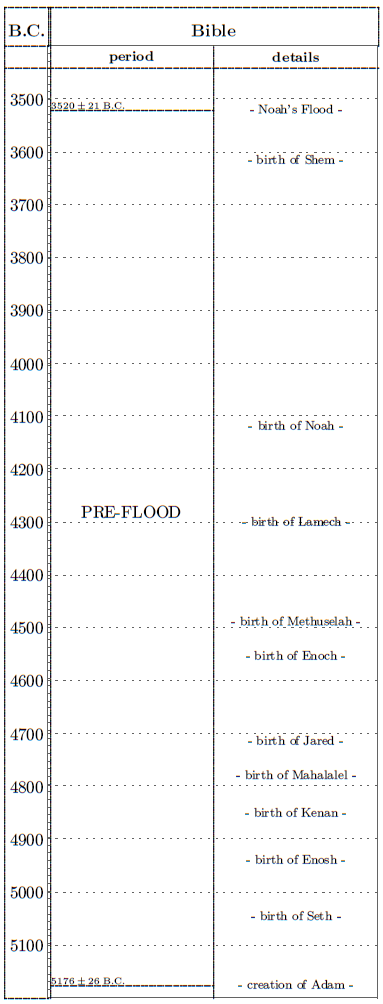 |
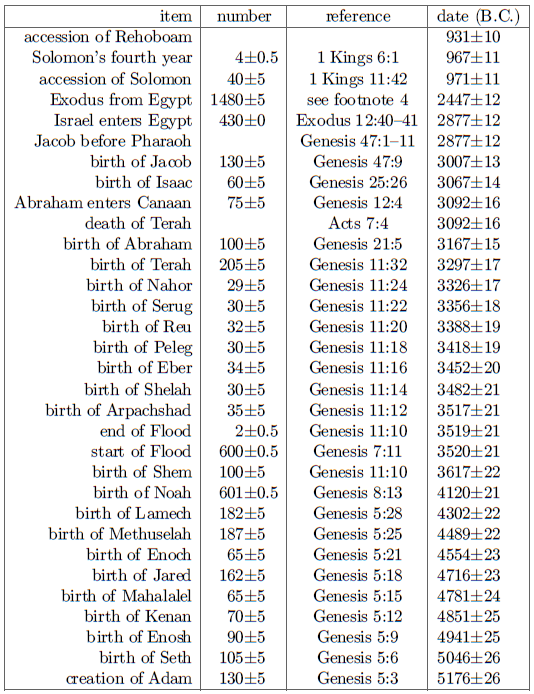 |
There is not much which needs to be said about this chronology. It is what the Masoretic Hebrew Text of the Old Testament yields when treated in a simple, straightforward manner. The only complexity is that one must recognize that "one thousand" has been lost from the text of 1 Kings 6:1 due to a copy error; one must recognize that the 480 years which appears in 1 Kings 6:1 today was originally 1,480 years.[4]
As usual, one must ask about the reliability of this chronology. Chronology building is a process in which we attempt to measure elapsed time from the present back to an event or series of events. Measurements of elapsed time entail uncertainties, as is true of all physical measurements. This chronology, for example, relies heavily upon genealogical data found in Genesis 5. Many have asked whether this genealogical data is complete, or whether it might contain gaps, with the result that the chronology obtained from it is foreshortened. Such uncertainties demand that we inquire into the degree of confidence which the chronology of Figure 1 warrants. How accurate is it likely to be?
The most compelling argument for confidence in this chronology at the present time is that it has been constructed using the same principles and procedures as our highly successful post-Flood Bible chronology. That is, I have used a simple, straightforward approach to the chronological data of the Masoretic Text, supplemented only by the restored "one thousand" in 1 Kings 6:1, in this pre-Flood portion of the chronology just as was done in the post-Flood portion. Nearly every past issue of this publication bears substantial testimony to the fact that this approach successfully integrates much Biblical and historical data. We have found this to be true from the time of Samuel right back into the time of Noah—a stretch of some two and a half thousand years. And a substantial portion of this interval was reliant upon the genealogical data of Genesis 11, just as the present portion of the chronology is reliant upon the genealogical data of Genesis 5. The overwhelming success of this approach in the post-Flood portion of Biblical chronology strongly recommends confidence in the results of this same approach in the pre-Flood portion.
I have previously discussed the significant textual variants which appear in many of the key numbers used to construct this portion of the chronology.[5] These and other considerations do caution against an inappropriate dogmatism—one will want to check this portion of our Biblical chronology in every conceivable way as usual, of course. But I have previously stated that "I will be very surprised if the true chronology which is finally obtained after all is said and done differs by more than a few centuries from that which the Masoretic text alone presents" and I will stand by this statement still.[6] Indeed, it seems even more likely to be correct now than it did when first asserted two years ago.
In support of this assertion note that the date for the creation of Adam which I have found in Figure 1, i.e., 5176±26 B.C., is very much in line with the work of other Biblical chronologists down through the centuries. It diverges significantly from the 4004 B.C. result of Bishop Ussher, of course, but this is almost entirely a consequence of his failure to notice the missing thousand years in 1 Kings 6:1. (It is hardly surprising that he failed to notice this since it is only the work of recent decades in the area of Biblical archaeology which has made this missing thousand years obvious, as I have previously pointed out.[7]) When this missing millennium is added in, Bishop Ussher's result becomes 5004 B.C., less than two centuries from my result. The divergence between our respective measurements of the elapsed time from Adam to the present is, in this case, in fact, just 2.4%.
Early chronologists tended to work from the Septuagint rather than the Masoretic Text. Sextus Julius Africanus ( c. A.D. 170–240) arrived at a date of 5502 B.C. for the creation of Adam by doing so.[8] No adjustment of this date by restoration of "one thousand" should be attempted. I have previously pointed out that the numbers of significance to Biblical chronology appear to have been deliberately altered in the Septuagint in an effort to compensate for the unrecognized, accidentally dropped "one thousand" years in 1 Kings 6:1 of the primary Masoretic Text.[9] Thus Africanus' result of 5502 B.C. is directly comparable to my 5176±26 B.C. The divergence in this case is three and a quarter centuries, or 6.3%.
These results, and many others similar to them by other Christian chronologists through the centuries, show that Biblical chronology does tend to converge somewhere within the second half of the sixth millennium B.C. for the creation of Adam. While claims which are extravagantly outside this range can be found today the science of Biblical chronology, both ancient and modern, does not encourage them.
For practical research purposes it seems reasonable to adopt the chronology shown in Figure 1 in the sense of a "working hypothesis", while bearing in mind the possibility that refinements to this chronology of even several centuries may yet be found necessary. Adjustments beyond this range do not seem possible, however. That the true date of the creation of Adam—the most remote and thus most uncertain point in this chronology—could differ from the date shown here by even as much as 500 years appears essentially impossible.
I showed last issue that pre-Flood Biblical history takes place in the Eden region and that this region is to be identified with the area at the head of the Persian Gulf—the region we call southeastern Iraq today.[10] It is clearly the secular historical and archaeological chronology of this region which is of interest to the present effort to unify sacred and secular chronologies in the pre-Flood period.
Figure 2 shows a modern secular chronology of this region which is widely known and applied within the technical literature at present.[11] The periods are named after the archaeological sites in South Mesopotamia (southeastern Iraq) where pottery and other archaeological artefacts characteristic of that time were first discovered. This is an archaeological chronology, not an historical one. That is, it has been built up from archaeological data without the aid of historical documents (since no secular written materials are found prior to Late Uruk times). Archaeological stratigraphy has been used to determine the relative chronology, and this has been supplemented by radiocarbon to obtain the absolute chronology.
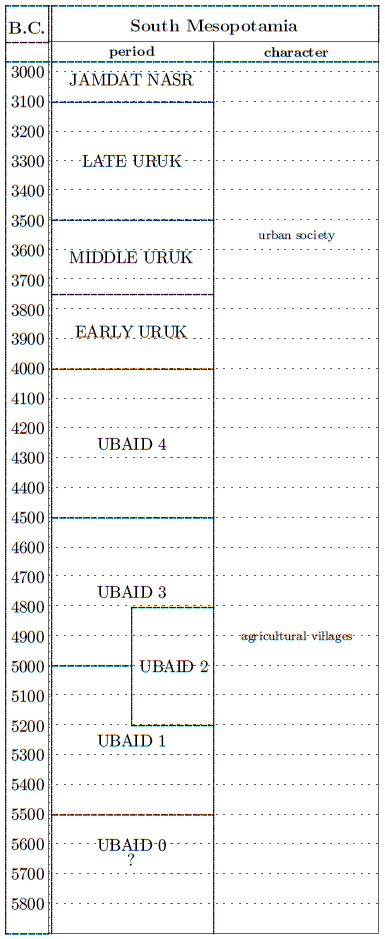 |
The Ubaid period seems characterized by settled agricultural villages, with abundant, decorated pottery and well-built multi-room houses. This characterization transforms into a fully urban society during the Uruk.
That the chronology of South Mesopotamia is not yet settled can be seen by comparing Figure 2 with a corresponding chronology published in the Cambridge Ancient History two decades earlier.[12] There we find the Ubaid to Uruk boundary 500 years later (at 3500 B.C.) and the dawn of the Ubaid well over a millennium later (at 4300 B.C.). Such large adjustments to this chronology over the past several decades make it unlikely that the chronology shown in Figure 2 is the final answer.
And indeed, the possibility of substantial departures from the Figure 2 chronology can be found in the modern technical literature. Joan Oates observes, for example:[13]
Other [radiocarbon] determinations… place the end of Ubaid significantly earlier—perhaps as early as 4800 BC, with its earliest phases presumably to be dated before 6000. Whichever chronological approximation we accept, we must also accept an Uruk period approaching or even exceeding 1500 years.
These observations demonstrate two important facts. First, adjustments of even 800 years to the Figure 2 chronology are not unthinkable at the present time. Second, Figure 2 almost certainly represents a minimum chronology for South Mesopotamia—the true chronology is probably centuries older at all points.
Porada et al. were quite clear that their Figure 2 chronology was already out of date at the time of its publication, so some effort to update it seems called for.[14] Modification of the Figure 2 chronology is also called for by what we know of the Flood at present. We feel reasonably confident from several lines of evidence that the Flood happened near 3500 B.C.,[15] and archaeological considerations seem to place the Flood at the Uruk to Jamdat Nasr boundary as I have previously argued.[16] Thus, there seems sufficient reason to believe that the true chronology of South Mesopotamia will place the Uruk to Jamdat Nasr boundary near 3500 B.C., rather than the 3100 B.C. of Figure 2. Purely secular chronological considerations seem to support this as well, as I have previously explained.[17]
Given 1) the obviously unfinished character of the secular chronology at present, 2) the significant indications that the Figure 2 approximation needs to be considerably lengthened, and 3) the evidence from many fields that the Flood happened near 3500 B.C., it seems reasonable to suggest that Figure 2 be modified for the present purpose by the addition of 400 years to the B.C. dates at all points, as is shown in Figure 3. This single alteration does not fix everything which might be wrong with the Figure 2 chronology, of course. But it does bring the Uruk to Jamdat Nasr boundary into coincidence with the Flood. And it also moves the Ubaid to Uruk boundary one half the distance Oates has suggested may be called for. Thus, it should give us a better approximation of the true chronology of South Mesopotamia than Figure 2 alone presents.
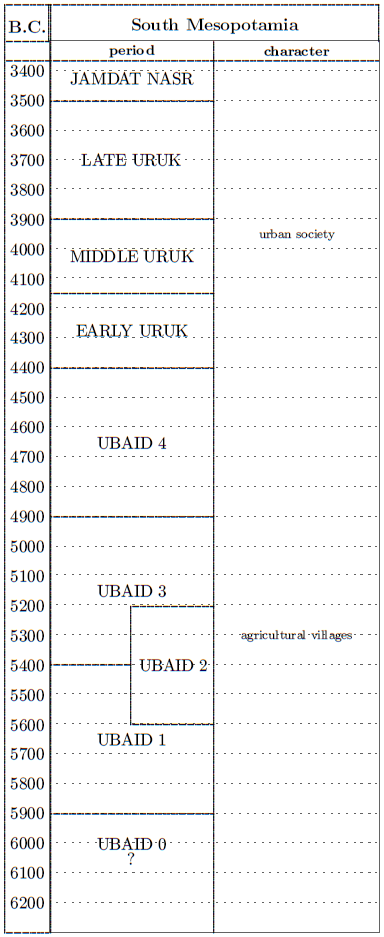 |
Still, Figure 3 is just an approximation, of course. The fact is that the secular chronology of South Mesopotamia is rather uncertain at the present time. This does not indicate any lack of ability on the part of the secular chronologists, but rather the inherent difficulty of building an accurate chronology at such an early time. I mention this only in passing, to point out the great privilege the Bible affords its readers in the relative ease with which remote chronology can be accurately determined from its pages.
Taking all factors into consideration it seems reasonable to assign an absolute uncertainty (3σ) of two centuries to the Uruk to Jamdat Nasr boundary, and five centuries to all points within the Ubaid in Figure 3.
Figure 4 shows the two chronologies, sacred and secular, side by side. We must now ask if these two are compatible. In keeping with sound research strategy we prosecute this question from the more recent to the more remote times, looking for the most recent point of divergence.
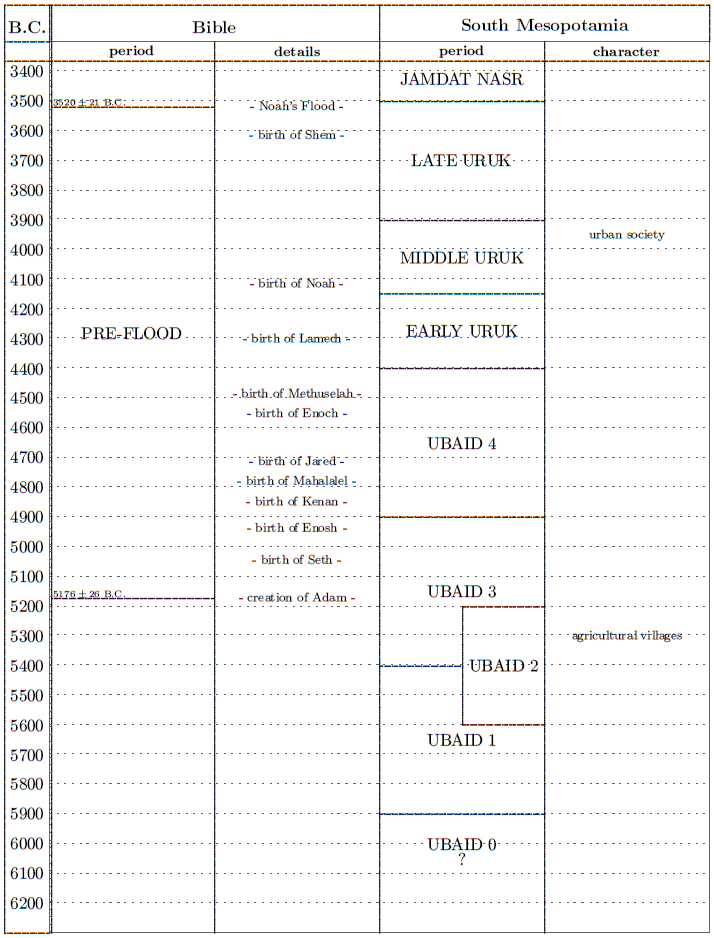 |
Our departure point is Noah's Flood, in the middle of the fourth millennium B.C. Previous issues of this publication have thoroughly discussed this important historical event and its significance to the unification of sacred and secular history, so there is no need to dwell upon it here. It is the earlier times which are now of interest.
Unfortunately, the Biblical narrative provides us with very little history in the five centuries of the fourth millennium which precede the Flood. As a result there is not much we can compare to the secular record. However, it is normal to picture Noah and his sons busily constructing the ark in the century before the Flood, and this provides one checkpoint. Is ship-building a known industry in South Mesopotamia by Late Uruk times?
J. N. Postgate provides the following answer. "Boat-building certainly goes back to the Ubaid period in Mesopotamia…"[18]
Clearly there is no anachronism immediately apparent in Noah and his sons building a ship—even a very large ship—in the technologically advanced, fully urban setting of Late Uruk times. Boat-building technology had been in place for probably a thousand years or more by then.
If chronologically controlled Biblical history is sparse in the first half of the fourth millennium B.C., it is all but absent in the fifth millennium. Genesis 5 provides us with the names of eight individuals who were born in succession during this millennium, but no historical details are furnished with this Biblical list.
One might attempt an investigation of the long lives of these individuals. Does archaeology reveal that some people were living for a very long time during the Ubaid and Uruk periods in South Mesopotamia? But it is very difficult to see how to investigate this question. One could study skeletal remains, but what will the skeleton of an individual who lived to be 900 years old look like? Will it be distinguishable from that of an individual who lives to be 90 years old today? We do not know the answers to these questions at present.
There probably are clever ways in which archaeology might get at the question of human longevity. Unfortunately, archaeologists are hardly taking the Bible seriously any longer back at these early times, so virtually no creative thinking is being invested in such questions at present. This potential check is thus not currently available to us.
Genesis 4:16–24 provides us with a few snatches of history through its recitation of the list of Cain's descendents. But no chronological data is furnished in Genesis 4, and the detailed interpretation of the snatches of history which it provides is far from clear. All that seems safely inferred from these verses is that we should place the origin of tents, musical instruments, and metallurgy in the pre-Flood rather than the post-Flood period. I am aware of nothing against this assertion, and I have previously presented some compelling evidence in support of the metallurgy part of it.[19]
Thus, we have very little Biblical history to go on. It would be an overstatement to claim that sacred and secular chronologies positively harmonize in the fifth millennium and first half of the fourth millennium. But on the other hand it would be altogether false to claim that the two chronologies disagree; no point of divergence is apparent between the two chronologies during these millennia. Consequently it is appropriate to push the investigation back into the sixth millennium B.C.
The sixth millennium takes us back, by any reasonable secular chronology, into the Ubaid. Biblically it takes us back into the first generation after Adam and ultimately to the creation of Adam himself.
Working our way methodically back in time, we first encounter the generation of Adam's immediate children. Genesis 4:2 informs us that one of Adam's sons was "a keeper of flocks" while another was "a tiller of the ground". Here is a checkpoint. Are these two occupations present within the archaeological data of the Ubaid?
The answer to this question is an unqualified yes. The most extensive recent information on the Ubaid in South Mesopotamia has come from archaeological excavations at Tell el'Oueili. Jean-Louis Huot relates what has been found there:[20]
At 'Oueili, the botanical remains were collected by flotation, and by the examination of imprints in clay…The main plant grown was six-rowed hulled barley ( Hordeum vulgare), of which seeds and internodal stems have been recovered. … As for wheat, the species in question is einkorn ( Triticum monococcum), but this crop is of lesser importance.
We possess but little information about oil-crop plants. Only a single imprint and a grain of flax from the 'Ubaid 4 levels have been found, of the domesticated variety according to its size ( Linum usitatissimum). The presence of the date-palm should also be noted…
Faunal analyses have been carried out by J. Desse… For this entire period, the most striking fact is the low proportion of sheep and goats: only 16.8%, compared with 37.6% of pigs and 45.5% of cattle. All these remains come from domesticated animals.
So there is clearly nothing anachronistic about Adam's sons keeping flocks and tilling the ground. Nor have I been able to find anything else about the Biblical narrative of the first generation after Adam which seems out of place in the Ubaid.
This takes us back to the generation of Adam himself. It is here that we encounter the first real difficulty. There is nothing about the agricultural lifestyle of Adam and Eve, either while they are living in the Garden of Eden or after they have been banished from it, including the cultivation of fruit trees, which is anachronistic. Such a lifestyle is quite appropriate to the settled agricultural setting of South Mesopotamia during the Ubaid revealed by archaeology. The great difficulty is that we had expected Adam and Eve to be the first man and first woman ever created. Isn't this what the Bible teaches, and what Christians have historically believed? How then can the creation of Adam and Eve be chronologically situated in the middle of the Ubaid, an archaeological period overflowing with evidence of human existence and activity throughout?
Evidence of the existence of mankind prior to the creation of Adam and Eve is very surprising. We are immediately caused to wonder whether some chronological blunder has been committed. But try as we might, no intelligent solution in terms of chronological error appears.
If we push Biblical chronology to its breaking point and move the creation of Adam by 500 years to 5700 B.C., while leaving the secular chronology of Figure 4 alone, we still have the same problem—the creation of Adam still occurs part way through the Ubaid. If we push hard against the secular chronology and move the dawn of the Ubaid forward 500 years, while leaving Biblical chronology alone in Figure 4, we still have the problem.
If we push both Biblical chronology and secular chronology to their breaking points we may possibly be able to place the creation of Adam at the dawn of the Ubaid. This depends, of course, upon just how remote the dawn of the Ubaid is eventually found to be by the archaeologists (who have so far been prevented by ground water from digging to the bottom of the Ubaid at 'Oueili). But we are certainly out on a limb with such a procedure. If it is improbable that even one of these two chronologies should be out by 500 years—and it is—then it is, of course, highly improbable that they should both be out by that much.
But such forcing of the chronological data would be folly. It would be folly not only because of its improbability, but also because it does not solve the problem of the apparent existence of mankind prior to the creation of Adam anyway. While human culture prior to Ubaid 0 is presently unknown to archaeology in South Mesopotamia, there is ample evidence of human existence prior to Ubaid 0 times in North Mesopotamia and elsewhere, such as Palestine. And this evidence stretches back over thousands of years prior to the Ubaid.
All of the Ubaid levels reveal that the Ubaid people were making and using decorated pottery. As one moves stratigraphically lower at other archaeological sites, such as Jericho in Palestine, one eventually encounters archaeological strata in which no pottery fragments are found at all. These imply that the technology of pottery manufacture had not yet even been discovered at their very early times. Such pre-pottery strata at Jericho date back to at least 8000 B.C.
Thus, secular chronology finds mankind in existence thousands of years before the Biblical date of the creation of Adam. This is the central conundrum of pre-Flood Biblical chronology for the conservative Christian. No appeal to chronological blunder can solve this conundrum. One can try to avoid the problem by embracing chronological anarchy—one can claim that secular chronology is meaningless. But we have not found the Exodus, the Conquest, and the Flood within the secular data by embracing chronological anarchy. The true solution, we believe, will be found in some other direction. ◇
The Biblical Chronologist is a bimonthly subscription newsletter about Biblical chronology. It is written and edited by Gerald E. Aardsma, a Ph.D. scientist (nuclear physics) with special background in radioisotopic dating methods such as radiocarbon. The Biblical Chronologist has a threefold purpose: to encourage, enrich, and strengthen the faith of conservative Christians through instruction in Biblical chronology, to foster informed, up-to-date, scholarly research in this vital field within the conservative Christian community, and to communicate current developments and discoveries in Biblical chronology in an easily understood manner. An introductory packet containing three sample issues and a subscription order form is available for $9.95 US regardless of destination address. Send check or money order in US funds and request the "Intro Pack." The Biblical Chronologist (ISSN 1081-762X) is published six times a year by Aardsma Research & Publishing, 412 N Mulberry, Loda, IL 60948-9651. Copyright © 1998 by Aardsma Research & Publishing. Photocopying or reproduction strictly prohibited without written permission from the publisher.
|
^ Gerald E. Aardsma, A New Approach to the Chronology of Biblical History from Abraham to Samuel, 2nd ed. (Loda IL: Aardsma Research and Publishing, 1993).
^ Gerald E. Aardsma, "Biblical Chronology 101," The Biblical Chronologist 4.3 (May/June 1998): 6–10.
^ Gerald E. Aardsma, "Chronology of the Bible: 5000–3000 B.C.," The Biblical Chronologist 2.4 (July/August 1996): 1–5.
^ Gerald E. Aardsma, A New Approach to the Chronology of Biblical History from Abraham to Samuel, 2nd ed. (Loda IL: Aardsma Research and Publishing, 1993).
^ Gerald E. Aardsma, "Chronology of the Bible: 5000–3000 B.C.," The Biblical Chronologist 2.4 (July/August 1996): 3.
^ Gerald E. Aardsma, "Chronology of the Bible: 5000–3000 B.C.," The Biblical Chronologist 2.4 (July/August 1996): 5.
^ Gerald E. Aardsma, A New Approach to the Chronology of Biblical History from Abraham to Samuel, 2nd ed. (Loda IL: Aardsma Research and Publishing, 1993), 26.
^ Jack Finegan, Handbook of Biblical Chronology (Princeton: Princeton University Press, 1964), 146.
^ Gerald E. Aardsma, "Chronology of the Bible: 5000–3000 B.C.," The Biblical Chronologist 2.4 (July/August 1996): 5.
^ Gerald E. Aardsma, "The Location of Eden," The Biblical Chronologist 4.3 (May/June 1998): 1–5.
^ Edith Porada, Donald P. Hansen, and Sally Dunham, "The Chronology of Mesopotamia, ca. 7000-1600 B.C.," in Chronologies in Old World Archaeology, volume 2 (Chicago: The University of Chicago Press, 1992), 94,96.
^ I.E.S. Edwards, C.J. Gadd, and N.G.L. Hammond, ed. The Cambridge Ancient History, vol. 1, part 2. (Cambridge: Cambridge University Press, 1971), 997.
^ Joan Oates, "'Ubaid Chronology," Chronologies in the Near East, ed. O. Aurenche, J. Evin, and F. Hours (Oxford: BAR International Series 379 (ii), 1987), 474.
^ Edith Porada, Donald P. Hansen, and Sally Dunham, "The Chronology of Mesopotamia, ca. 7000-1600 B.C.," in Chronologies in Old World Archaeology, volume 1 (Chicago: The University of Chicago Press, 1992), 121.
^ Gerald E. Aardsma, "Chronology of the Bible: 5000–3000 B.C.," The Biblical Chronologist 2.4 (July/August 1996): 1–5; Gerald E. Aardsma, "Noah's Flood at Elk Lake," The Biblical Chronologist 2.6 (November/December 1996): 1–13; Gerald E. Aardsma, "Noah's Flood at Devon Island," The Biblical Chronologist 3.4 (July/August 1997): 1–16; Gerald E. Aardsma, "Radiocarbon Dating Noah's Flood," The Biblical Chronologist 3.6 (November/December 1997): 1–11.
^ Gerald E. Aardsma, "Research in Progress," The Biblical Chronologist 1.4 (July/August 1995): 6–10.
^ Gerald E. Aardsma, "Research in Progress," The Biblical Chronologist 1.4 (July/August 1995): 8.
^ J.N. Postgate, Early Mesopotamia: Society and Economy at the Dawn of History (New York: Routledge, 1994), 230.
^ Gerald E. Aardsma, "Radiocarbon Dating Noah's Flood," The Biblical Chronologist 3.6 (November/December 1997): 1–11.
^ Jean-Louis Huot, "Ubadian Villages of Lower Mesopotamia," Upon This Foundation – The Ubaid Reconsidered (Copenhagen: University of Copenhagen, 1989), 26–27.